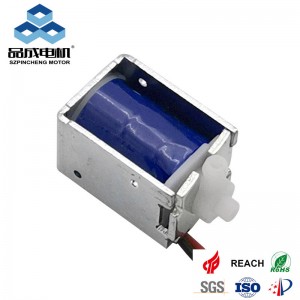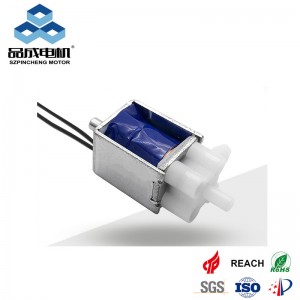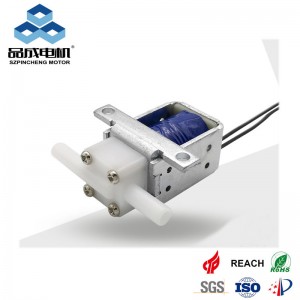Micro solenoid valves play a pivotal role in industries ranging from aerospace to medical devices, where split-second fluid control is critical. A delay in their response time can compromise system efficiency, accuracy, and safety. This comprehensive guide explores cutting-edge strategies to enhance micro solenoid valve performance, backed by real-world applications and industry innovations.
1. Magnetic Circuit Design and Material Optimization
The heart of any solenoid valve is its magnetic circuit. Innovations in this area have driven significant improvements in response speed. For instance, the China Aerospace Science and Technology Corporation developed a lightweight cryogenic solenoid valve for liquid oxygen-methane engines, achieving a 20% reduction in response time through optimized magnetic flux distribution . Key techniques include:
- High-Permeability Cores: Using soft magnetic materials like iron-silicon alloys or powder metallurgy (PM) components enhances magnetic saturation, reducing energization time .
- Magnetic Isolation Rings: Strategic placement of isolation rings minimizes eddy currents, improving dynamic response. Studies show that adjusting the ring position along the z-axis can reduce response time by up to 30% .
- Ultra-High-Temperature Sintering: Heating PM components to 2500°F during manufacturing increases grain size and magnetic permeability, resulting in faster magnetization .
2. Structural Redesign for Mechanical Efficiency
Mechanical resistance is a primary bottleneck in valve responsiveness. Engineers are reimagining valve architectures to overcome this:
- Lightweight Actuators: Replacing traditional steel cores with titanium or carbon-fiber composites reduces inertia. For example, the 300N LOX-methane engine valve achieved sub-10ms response times using lightweight materials .
- Optimized Spring Systems: Balancing spring stiffness ensures rapid closure without compromising sealing force. The sloped seat design in cryogenic valves maintains high sealing pressure at low temperatures while enabling faster movement .
- Fluid Path Optimization: Streamlined internal channels and low-friction coatings (e.g., PTFE) reduce flow resistance. The Limaçon gas expander valve achieved a 56–58% response improvement by minimizing fluid turbulence .
3. Advanced Control Electronics and Software
Modern control systems are revolutionizing valve dynamics:
- PWM Modulation: Pulse Width Modulation (PWM) with high-frequency holding currents reduces power consumption while maintaining rapid actuation. Studies using Response Surface Methodology (RSM) found that optimizing PWM parameters (e.g., 12V, 15ms delay, 5% duty cycle) can cut response time by 21.2% .
- Dynamic Current Control: Intelligent drivers like the Burkert 8605 controller adjust current in real-time to compensate for coil heating, ensuring consistent performance .
- Predictive Algorithms: Machine learning models analyze historical data to predict and preempt delays caused by wear or environmental factors.
4. Thermal Management and Environmental Adaptation
Extreme temperatures can drastically affect valve performance. Solutions include:
- Cryogenic Insulation: Aerospace-grade valves use air-gap insulation and thermal barriers to maintain stable coil temperatures between -60°C and -40°C .
- Active Cooling: Microfluidic channels integrated into valve bodies dissipate heat, preventing thermal expansion that causes delays.
- Temperature-Resistant Materials: Nitrile rubber seals and stainless-steel components withstand fluctuations from -196°C to 100°C, ensuring reliability in cryogenic and high-temperature applications .
5. Testing and Validation
Accurate measurement is crucial for optimization. Industry standards like ISO 4400 require response times below 10ms for high-performance valves . Key tests include:
- Respond analysis: Measuring the time to reach 90% of full pressure during opening and 10% during closing .
- Lifetime Testing: The 300N LOX-methane valve underwent 20,000 cycles of liquid nitrogen exposure to validate durability .
- Dynamic Pressure Testing: High-speed pressure sensors capture real-time performance under varying loads.
6. Real-World Applications
- Aerospace: Lightweight cryogenic valves enable precise thrust vector control in reusable rockets .
- Automotive: Fuel injectors using PWM-controlled solenoids achieve sub-5ms response times, improving fuel efficiency .
- Medical Devices: Miniaturized valves in drug delivery systems use nested Hall thrusters for nanoliter-scale precision .
Conclusion
Optimizing micro solenoid valve response time requires a multidisciplinary approach, combining materials science, electronics, and fluid dynamics. By implementing magnetic circuit innovations, structural redesigns, and smart control systems, engineers can achieve sub-10ms response times while ensuring reliability across extreme conditions. As industries demand faster and more efficient solutions, these advancements will remain critical for next-generation precision engineering.
Stay ahead of the curve—explore our range of high-performance micro solenoid valves designed for unmatched speed and durability.
you like also all
Post time: Apr-07-2025




